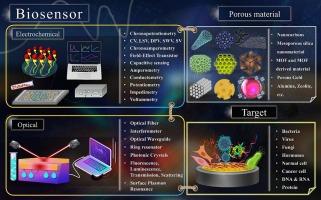基于纳米多孔结构的环境和生物医学诊断生物传感器:进展、机遇和挑战
IF 20.3
1区 化学
Q1 CHEMISTRY, INORGANIC & NUCLEAR
引用次数: 0
摘要
作为新兴平台,基于纳米多孔的生物传感器在灵敏和选择性检测各种分析物方面具有潜在的应用价值。将纳米多孔材料(如纳米碳、介孔、金属有机框架(MOF)和基于 MOF 的纳米复合材料等)与电化学、光学和质量敏化等各种传导技术相结合,开发出了可广泛应用于医疗保健、环境监测和食品安全领域的生物传感器。这些生物传感器利用了纳米多孔材料的独特性能,例如可调孔径和高比表面积的选择性表面化学性质,增强了分析物与识别元件之间的相互作用。总体而言,基于纳米多孔材料的生物传感器具有极低的检测限和适当的线性范围。本综述重点介绍基于纳米多孔材料的生物传感器设计的最新进展,包括传感机制和应用。本文章由计算机程序翻译,如有差异,请以英文原文为准。

Nanoporous structures-based biosensors for environmental and biomedical diagnostics: Advancements, opportunities, and challenges
As emerging platforms, nanoporous-based biosensors have potentially useful applications for sensitive and selective detection of various analytes. The integration of nanoporous materials (e.g., nanocarbons, mesoporous, metal–organic frameworks (MOFs), and MOF-based nanocomposites, etc.) with various transduction techniques, such as electrochemical, optical, and mass-sensitized, has led to the development of biosensors for a wide spectrum of applications in healthcare, environmental monitoring, and food safety. These biosensors take advantage of the unique properties of nanoporous materials, such as tunable pore size and selective surface chemistry with high surface area, and enhance the interaction between the analyte and the recognition element. Overall, biosensors based on nanoporous material have very low limits of detection and appropriate linear range. This review focuses on recent developments in the design of biosensors based on nanoporous materials, including sensing mechanisms and applications.
求助全文
通过发布文献求助,成功后即可免费获取论文全文。
去求助
来源期刊

Coordination Chemistry Reviews
化学-无机化学与核化学
CiteScore
34.30
自引率
5.30%
发文量
457
审稿时长
54 days
期刊介绍:
Coordination Chemistry Reviews offers rapid publication of review articles on current and significant topics in coordination chemistry, encompassing organometallic, supramolecular, theoretical, and bioinorganic chemistry. It also covers catalysis, materials chemistry, and metal-organic frameworks from a coordination chemistry perspective. Reviews summarize recent developments or discuss specific techniques, welcoming contributions from both established and emerging researchers.
The journal releases special issues on timely subjects, including those featuring contributions from specific regions or conferences. Occasional full-length book articles are also featured. Additionally, special volumes cover annual reviews of main group chemistry, transition metal group chemistry, and organometallic chemistry. These comprehensive reviews are vital resources for those engaged in coordination chemistry, further establishing Coordination Chemistry Reviews as a hub for insightful surveys in inorganic and physical inorganic chemistry.
 求助内容:
求助内容: 应助结果提醒方式:
应助结果提醒方式:


